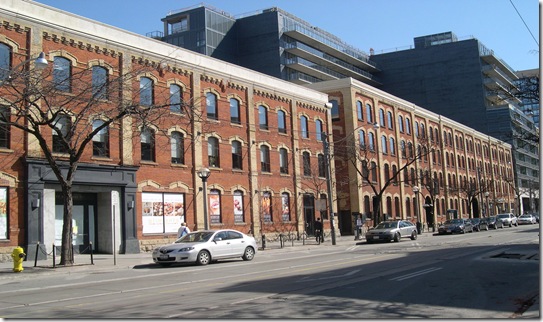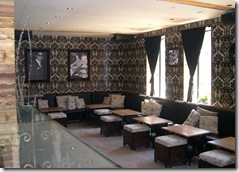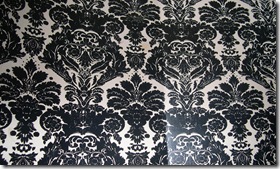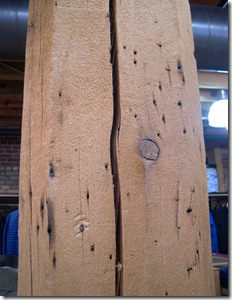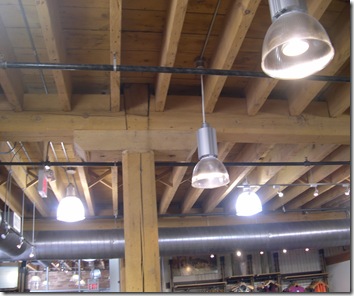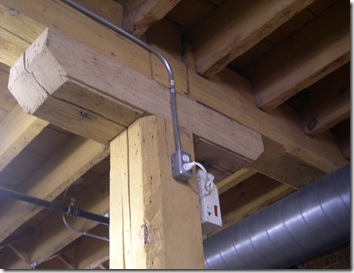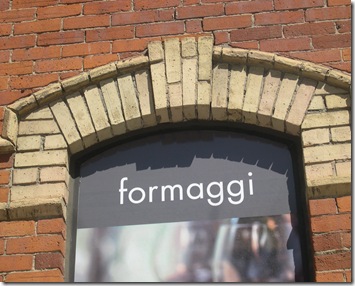Today I had lunch at Atelier Cafe Lounge on King Street West, located within the building that once housed the nineteenth-century Gurney Stove Foundry. Atelier is a one-of-a-kind cafe, with cozy atmosphere and a unique setting, an ideal place to enjoy a cappuccino or latte and a sandwich. The wallpaper in the cafe remains from the days when the space was a private club. The owners are proud to point out that the wallpaper is a signature feature of the cafe. It is a nineteenth-century pattern, and was popular in the days when the stove foundry was built, even though it would have been out of place in an industrial complex.
Interior of the Atelier Cafe Lounge and its signature wallpaper
Gazing at the well-worn oak floors and the massive beams of old-growth pine within the cafe, as I sipped on my coffee, I thought of the history contained within the walls of this magnificent old structure. The following section is from the book “The Villages Within”, and tells about the history of the Gurney Stove Foundry.
The Gurney Stove Foundry, 500–522 King Street, Northeast Corner of King and Brant Streets
The magnificent Victorian buildings, constructed of red and yellow brick, are among the oldest industrial structures in the city. The building on the east (closest to Spadina) is the oldest. With a history that spans almost a century and a half, the E. C. Gurney Company, originated in Hamilton, Ontario. Edward and Charles Gurney manufactured stoves and general castings. When business expanded, the Gurney brothers opened a retail store in Toronto at 91 Yonge Street. Edward Gurney Junior relocated to Toronto to manage the family business in the provincial capital, purchasing a residence at 209 Jarvis Street for his family.
During the 1870s, much of the land along King Street West was vacant, although it was privately owned. Children in the area ran freely in the fields, kicking a ball and shouting to friends to join in their game. In autumn, the grasshoppers flew in clouds as the children raced along the paths among the fields. In winter, they built snow forts, engaged in snowball fights, and employed creative cursing when they received a direct hit in the face. However, it was soon to change, as the natural playground was to be buried beneath an enormous industrial complex.
Intending to build a factory in Toronto, in 1872, the Gurney Company bought several of the lots on King, west of Spadina, and erected a four-storey building. Located on the east side of the property, its brick walls were particularly attractive, especially the yellow-brick designs above the windows and the yellow-brick pilasters (fake columns) that commenced at the ground level and rose to the top of the building. In 1872, the postal address of the factory was 356 King Street, but today it is 500–510 King Street West. They also constructed more buildings to the north of the King Street structures, but they have not survived into the modern era.
When the building opened, which today has the postal address 500-510 King Street, a newspaper advertisement stated, “Gurney Stove Foundry, manufacturing agent for the famed Buttan Heater.”
The business expanded and in 1887 they constructed a three-storey building to the west of the original site. Its address today is 522 King Street. A narrow laneway separated the two structures. During the following years, other buildings appeared to the north of the original two, but these have since been demolished.
The buildings deteriorated throughout the years ahead and their attractive facades were covered with a tin siding. In the modern era, when its owners decided to restore the buildings, they removed the tin, revealing the attractive brickwork. It now appears as it did in yesteryear. During the restoration, they replaced the cornices on both structures with metal trim.
In the laneway between the two surviving buildings on King Street, they erected a connecting passageway at the second and third-floor levels. Thankfully, it matches the two existing buildings. Today, multiple tenants are located within. With its polished original oak floors and massive wood beams of old-growth Canadian pine, it possesses some of the most handsome nineteenth-century rental spaces in the city.
Viewing these restored buildings today, it is difficult to imagine them being a part of a bustling, sooty, industrial complex, with hundreds of workers labouring in hot, fetid conditions to tend the furnaces, shovelling coal to keep the fires alive. It was an era when workers possessed few rights. Wages were poor and hours were long, usually nine or ten hours a day, six days a week. Lung disease and work-related illnesses were common.
To the modern eye, these factories appear pristine and quaint, their patterned brickwork attractive to behold. The massive pine pillars, visible through the windows of the storefronts, inspire awe. No trees remain in Ontario to obtain such magnificent giants ever again.
No trace remains of the hardworking labourers who once worked on these premises. Evidence of their joys and sorrows has long departed the scene. Only the rattle of the streetcars on the street or the shout of a truck driver remind us of earlier days, when this was a busy industrial complex. The past has departed forever, but evidence of earlier days remains through the presence of these attractive historic buildings.
Nineteenth-Century Pine Beams in the old Gurney Iron Foundry
Photographs below are of the interior of “Patagonia,” a stylish clothing store within the Gurney Stove Foundry,at 500 King St. West.
Attractive yellow and red brickwork on the facade of the Gurney Iron Foundry
